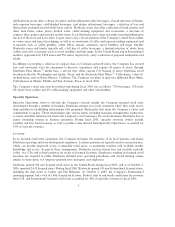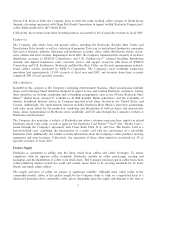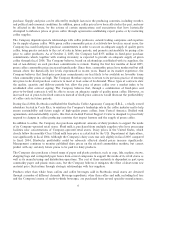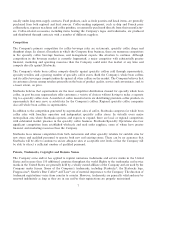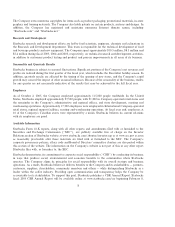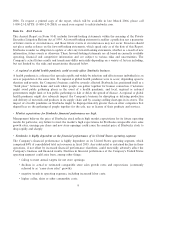Starbucks 2005 Annual Report Download - page 14
Download and view the complete annual report
Please find page 14 of the 2005 Starbucks annual report below. You can navigate through the pages in the report by either clicking on the pages listed below, or by using the keyword search tool below to find specific information within the annual report.‚Starbucks faces intense competition in the specialty coffee market.
There are numerous competitors in almost every market in which Starbucks operates and in which it expects
to expand in both the specialty coffee beverage business and the specialty whole bean coffee business. This is
especially true in the major metropolitan areas where Starbucks operates and expects to expand, in virtually all
of which there are local or regional competitors with substantial collective market presence. Although
competition in the specialty coffee beverage market is currently fragmented, a major competitor with
substantially greater financial, marketing and operating resources than Starbucks could enter this market at
any time and compete directly against Starbucks. The Company's whole bean coffees compete directly against
specialty coffees sold through supermarkets, specialty retailers and a growing number of specialty coffee
stores. Some of the Company's competitors in these whole bean specialty coffee distribution channels have
greater financial and marketing resources than Starbucks. Both the Company's whole bean coffees and its
coffee beverages compete indirectly against all other coffees on the market. Starbucks also faces well-
established competitors in many international markets. If Starbucks fails to maintain and build market share
in the specialty coffee market and the coffee market generally, it could harm the Company's business and
financial results.
‚Adverse public or medical opinions about the health effects of consuming the Company's products could
harm its business.
Some of the Company's products contain significant amounts of caffeine, dairy products, sugar and other
active compounds, the health effects of which are not fully understood or are the subject of increasing public
scrutiny. A number of research studies have concluded or suggested that excessive consumption of caffeine
can lead to a variety of adverse health effects. There has also been greater public awareness that sedentary
lifestyles, combined with excessive consumption of high-calorie foods, have led to a rapidly rising rate of
obesity. Particularly in the United States, there is increasing consumer awareness of health risks, including
obesity, due in part to increasing publicity and attention from health organizations, as well as increased
consumer litigation based on alleged adverse health impacts of consumption of various food products. While
Starbucks has a variety of beverage and food items that are low in caffeine and calories, an unfavorable report
on the health effects of caffeine or other compounds present in the Company's products, or negative publicity
or litigation arising from other health risks such as obesity, could significantly reduce the demand for the
Company's beverages and food products.
‚Significant increases in the market price or decreases in availability of high quality arabica coffee could
harm the Company's business and financial results.
The supply and price of coffee are subject to significant volatility. Although most coffee trades in the
commodity market, high-altitude arabica coffee of the quality sought by Starbucks tends to trade on a
negotiated basis at a substantial premium above commodity coffee prices, depending on the supply and
demand at the time of purchase. Supply and price can be affected by multiple factors in the producing
countries, including weather, political and economic conditions. In addition, green coffee prices have been
affected in the past, and may be affected in the future, by the actions of certain organizations and associations
that have historically attempted to influence prices of green coffee through agreements establishing export
quotas or restricting coffee supplies. Any significant increase in the market price or any significant decrease in
the availability of high quality arabica coffee could adversely affect the Company's business and financial
results. Starbucks also purchases large quantities of dairy products Ì particularly milk. Any significant
increase in the market price or decrease in availability of dairy products could harm the Company's business
and financial results.
12



